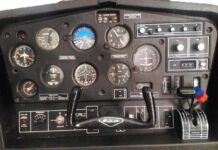Thanks for another great edition of IFR. I enjoyed the “Partial Panel with GPS” article. However, I have an issue with the “Getting the GPS Screens Right” sidebar.
In my experience, pilots find it difficult to determine left from right if they are trying to fly numeric DTK and TRK. In general, I recommend against doing math in your head in the cockpit, especially when you are mentally overloaded flying partial panel. If TRK and DTK differ by two degrees, it can be distracting having to figure out if that is two degrees left or two degrees right.
To see how easy it is to get left and right confused, notice that you yourself got twisted around in the sidebar. You wrote that the CDI indicates we are right of course, when in fact, the picture indicates we are left of course. Consequently, I would emphasize your second recommendation: Fly using the moving map to help keep yourself oriented visually. A picture speaks a thousand words (or numbers).
I would also recommend changing the WPT field to TKE (Track Angle Error). TKE gives you a clear left/right turn command to make TRK match DTK (see below).
If you plan to reference GPS for direction, inform ATC that you are unable to accept headings and only can accept direct-to-waypoint instructions or no-gyro turn commands. That way you will preempt trying to figure out how to create a desired track on the GPS for an arbitrary heading assigned by ATC.
There are tricks for that, but realistically they are too distracting when partial panel.
Peter King
Bend, Ore.
For all of you who wrote in about the left/right error, know that Jeff has yet to screw this up in the cockpit. It’s only if he says or writes it that he can’t keep them straight. Next time it won’t be so cold in Maine, so he can take off his mukluks and see which hand makes the “L.”
TKE is a great tool if your GPS has it as an option. But not all GPS units, especially portables and tablets, offer it.
Another Way to Go
In response to “Filing for a Lat/Long” in January 2012 edition of IFR: Would it not be simpler to use the OBS mode of the Garmin GNS530W to fly the PMM radial in the amended clearance?
You’d program the 530 for “… PMM MKG FAH …,” and just before you reach PMM, hit the OBS key to suspend waypoint sequencing and maintain PMM as the active waypoint. Then turn the OBS to 333 and off you go, flying the 333 radial from PMM.
When you get close to intersecting V510 (either by eyeballing it or using your second radio/OBS to tune to the MKG 296 radial), hit OBS again to resume sequencing. Then on the FPL page, select MKG -> FAH as the active segment (scroll down to FAH and hit direct-to key twice).
That’s a bit of fiddling, but you have lots of time. There’s no rush. And IMHO, it’s a heck of a lot easier (and less error prone?) than trying to create a user waypoint based on a calculated Lat/Long. And you get to use that wonderful OBS mode that you know you always wanted to use!
Peter Mucklow
Ottawa, Canada
We won’t argue that your system will work. And if we got hit with this as a surprise in the air, it might be our solution. Simpler? That we might argue.
Simplicity or lack of it aside, being able to program the turn into the GPS has plenty of advantages: The autopilot can fly it, there’s no eyeballing or extra attention required, and most of all, all the work can be done before you launch.
Another plus is you see the route with the turn on any moving maps, which can be a huge boon if you’re also looking at weather and how it impacts your route.
Five-Minute METARs
Do you know of any reason in the computer/internet age why we only get hourly official METAR observations? This policy must date back to a time when observations were all done by men. I often wonder this when I am watching the weather closely at my destination while flying using XM, or Foreflight while pre-flight briefing.
Compared to the bandwidth to transmit weather radar, which can have five minute updates, the small amount of text required for each airport in the country would not be expected to be a problem.
I’d think the government could make observations every minute or every five minutes easily available to us. Some type of buffering of the observations, for ceiling and visibility, would be required. I wonder who in the FAA would have an interest in looking into the issue and seeing how hard it would be to make more frequent official observations available.
Justin Graff
Belden, Miss.
While it’s probably technically feasible, it may not matter much in practice. If conditions change significantly, there will be a SPECI issued. If you see one, that’s a clue that things are changing in some way or another. But you do bring up a good point that XM or ADS-B weather could be over an hour old. You should always check its age and grab the one-minute weather off the radio if you can. A change that matters to you might not be big enough to trigger a special report.
Visually Challenged
Read the nice article by Frank Bowlin (“Visual Departures for IFR,” February 2012 IFR). I want to ask about his comments on the visual approach, “… you’re expected to proceed directly to the airport … just set yourself up to directly enter the traffic-pattern leg that is most appropriate for your location.”
This is not exactly what I understand a visual clearance to require. My understanding is that you need not go directly to the field, but rather can fly along the final approach segment (if an IFR approach exists) of the runway in use. This can be especially useful at night to avoid terrain conflicts. A field I go to often, Wilkes-Barre, Pa., lies in a valley and has two ridges within a few miles on each side of the field. One doesn’t need to fly the entire approach, but maybe begin at the FAF. A few extra seconds, depending on where you are when you get the visual clearance.
There was just a long discussion of this very issue on the Cirrus owners website, and there seemed to be consensus that the extra protection gained by tracking a published approach segment was worth it and totally acceptable. This discussion was after some pilot came to grief who could have used such assistance.
So that is my approach, almost always at night, and often at unfamiliar places. Giving the impression that one must go “directly to the airport” may give someone the impression that the technique described above violates the FARs or ATC expectations. I don’t think either is correct but would welcome a discussion.
Andrew Doorey
Wilmington, Del.
Frank Bowlin replies: It is a clearance “… to proceed visually and clear of clouds to the airport.” (AIM 5-4-23.a) No further guidance is published. By “directly,” I meant it is not VFR flight where you can circle your house on the way. Instead, it’s an “own nav” clearance to the airport. It is often useful to intercept final for a published procedure, but it’s OK to enter the VFR traffic pattern if that helps.
Oh, and yes, I’ve flown a visual to Wilkes-Barre at night and, yes, I flew the ILS. Much safer. Especially in the approach category D boat I was flying. Enjoyed this little Italian restaurant in Old Forge …
A recent article in IFR described the Dalton visual departure at TEB, showing both the FAA and Jepp charts. But neither chart notes the required climb gradient is well above 500 feet per mile. The needed climb rate is in the range of 750 to 1300 FPM. This information would be useful to pilots using the Dalton procedure.
Dick Brodeur
North Palm Beach, Fla.
An excellent point. If you read the fine print, you’re expected to make the turn at 800 feet but within two miles of the VOR, so it’s worth thinking about how fast you’re going to get up and out.
Killer Kudos
That January 2012 Killer Quiz was the best one ever! That is exactly why I read your magazine: humor combined with really tough IFR lessons—”ask me in a few minutes” is the correct answer?! I learned more from that quiz than I have reading a dozen other articles—in other mags, of course.
Keep up the good (hard) work.
J. Sid del Cardayre
Richmond, Va.
There’s another one in this issue. Let us know how it rates.
Send kudos or sneers to [email protected].




